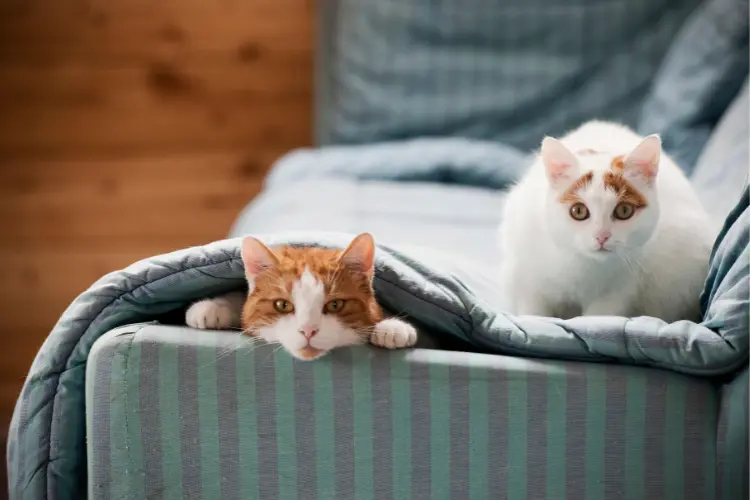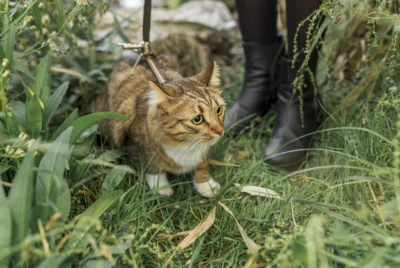How to Introduce Cats: Strategies for a Smooth Transition
Introducing a new feline friend to your resident cat can feel daunting, but fear not! With patience, planning, and the right approach, you can create a harmonious cat home where your feline companions thrive together.
Get ready to learn successful strategies for a smooth cat introduction and discover how to build positive associations between your cats for long-term harmony as we delve into “how to introduce cats” effectively.
Preparing for Your New Feline Friend
When welcoming a new cat into your home, consider age, energy levels, and whether the newcomer is used to other feline companies. Bringing a new cat into the mix can be a delicate process, as your current cat may feel threatened or territorial.
If the new cat is familiar with being around other cats, the introduction process could be smoother.
Ease your cats into the introduction process by ensuring they both have access to necessities such as:
- litter boxes
- scratching posts
- water and food bowls
- hiding and resting spaces
- toys
- human interaction
Providing these items for each cat will allow them to establish their own space and feel secure.
Moreover, when introducing an adult cat to your home, maintain the food they’re already accustomed to eating. This will help them feel more comfortable and secure during the transition.
Essential Supplies for Introducing Cats
Embarking on your cat introduction journey requires you to gather all necessary supplies for both your resident cat and the newcomer. Some of the items necessary for a smooth introduction include:
- Food
- Water
- A litter box
- A scratchpad
- Toys
When selecting a litter box, several types are available, such as open litter pans, hooded litter pans, automatic litter boxes, and disposable litter pans.
Remember, the goal is to ensure both cats are at ease during the introduction. Providing them with their own space and resources will help minimize any potential territorial disputes and create a smoother transition for both your existing and new cat.

The Gradual Introduction Process
A tried and true, step-by-step process is the best way to introduce one cat to another. Gradually introducing the cats using a baby gate can aid in forming a friendly bond, leading to a successful introduction of the new cat.
Be patient during cat introductions, as they can run longer than expected, sometimes from a few hours to even a few months.
Step 1: Establish Separate Spaces
To begin the introduction process, create separate spaces for each cat, ensuring they have all the necessary resources and comfort. This includes having:
- food
- water
- a litter box
- a scratch pad
- toys
For each of the individual cats, assigning their area allows them to spend time separately and feel secure. Many cats spend time in their designated spaces, contributing to their overall well-being. This is especially true when dealing with two cats in the same household.
Help your cats smell and hear each other by providing food by the door that separates them, allowing them to understand that being together can be enjoyable.
Additionally, using the same towel to give each cat a rub can help mix their scents and facilitate a smooth introduction.
To prevent any potential aggression, it is advisable to wait a day or two before moving on to the next step. This will give your cats time to adjust to each other’s presence and feel more comfortable in their new environment.

Step 2: Scent Swapping
Exchanging scents between the cats can help them become familiar with each other before physical encounters. You can use items such as:
- clean socks
- scent soakers
- towels
- blankets
These items should be lightly rubbed on each cat’s face or have absorbed their scent. Swapping scents can assist in making the cats feel more at ease with each other before a physical meeting.
It can take a few hours to a few months for cats to become accustomed to each other’s scent. Patience is key during this phase, as rushing the process can hinder the progress of a successful introduction.
After allowing ample time for scent swapping, you can move on to the next step, gradually introducing visual encounters between your cats.

Step 3: Controlled Visual Encounters
Controlled visual encounters can be introduced through barriers like baby gates or screen doors, allowing cats to see each other without physical contact. The “Raising the Curtain” technique involves:
- Draping a blanket over the gate or using clothespins to hang it from the screen to gradually increases visual access.
- Do this activity for 5 to 10 reps at a time.
- Repeat this set 2 to 3 times a day.
Gentle eye contact, slow blinking, and tails held high may indicate friendliness between your cats. If they seem scared or aggressive when they see each other through a pet gate, you can try distracting them with a toy, but if that doesn’t work, you may need to go back to the previous step.
Remember, you want to ensure a positive experience for both cats. It’s essential to end the interaction before either cat spends too much time in a stressful situation, ensuring a positive note for both parties.
Monitoring Interactions and Adjusting the Process
As the cats get to know each other, keep an eye on their interactions and tweak the introduction process as required. Taking your time and ensuring a smooth integration is crucial for fostering lasting peace between your cats.
If your cats still aren’t adjusting, it might be helpful to review the steps you have taken so far and consider consulting a certified behavior consultant for further advice.
Remember to allow all the cats to interact naturally, without forcing them to be what you think best buddies act like. Gradually extending their time together, while still providing separate areas and resources for each cat, will help create a more harmonious environment in your cat home.
If your cats still aren’t getting along, it may be worth trying the protocol again, but even more slowly. Patience and perseverance will pay off in the long run, ensuring a successful introduction for both your resident and new cat.
Read also: Top 10 Warning Signs When Introducing Cats
Building Positive Associations
Encouraging positive associations between your cats through treats, toys, and playtime during the introduction process is key to fostering a strong bond between them.
Offering food or treats that each cat loves, as well as spending time playing with them, can help create positive associations and reduce the chances of negative interactions.
Interactive play can help your cats become more comfortable with each other, further strengthening their bond.
If either cat shows signs of stress during interactive play, it may be beneficial to take the process more slowly and return to a previous step if needed.

Ensuring Long-term Harmony
To maintain long-term harmony and prevent fights, make sure each cat has enough resources and space. Make sure there are plenty of food bowls, water bowls, litter boxes, and scratching posts available for each cat.
High resting spaces can also be beneficial for cats, as it allows them to perch and feel safe, increasing the amount of territory in the home and creating a more harmonious environment.
Fostering a positive relationship between your cats takes time, patience, and dedication. Creating a harmonious environment where your resident and new cat can thrive is possible by following a gradual introduction process and providing each cat with their individual space and resources.
Frequently Asked Questions
Is hissing OK when introducing cats?
Hissing is normal and should not be of concern when introducing cats. Allow both cats to be out and watch for relaxed body language or light swatting as a sign of acceptance.
How to introduce a cat to a dog?
When introducing a cat and dog, ensure the cat has a safe area to retreat to, keep the animals separated initially, feed them on either side of a closed door, teach basic commands, and introduce face-to-face gradually while monitoring their behavior. Always proceed with caution and have the dog on a leash for safety.
Summary
Introducing a new feline friend to your resident cat may seem daunting, but with patience, planning, and the right approach, you can create a peaceful and harmonious cat home.
By understanding the importance of a gradual introduction process, providing essential supplies, fostering positive associations, and ensuring long-term harmony, you’re well on your way to creating a loving environment where both your resident and new cat can flourish together.
Remember, patience is key, and the bond that forms between your cats will be well worth the effort.




